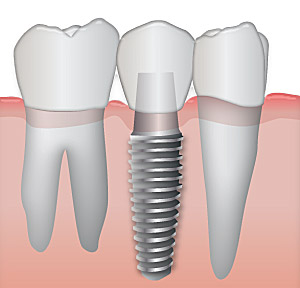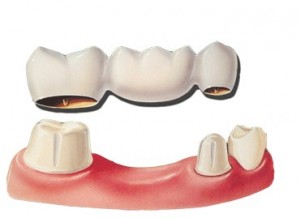‘I am missing a tooth. It does not bother me, so why should I bother replacing it?’
 Why should you replace a missing tooth? That missing tooth can keep you from chewing properly and speaking correctly. If you’ve lost a front tooth, you may have a gap in your smile. It may seem obvious that a missing tooth can change your chewing, your speech, and your looks. One thing you may not realize, though, is that a missing tooth can affect the health of the surrounding teeth.
Why should you replace a missing tooth? That missing tooth can keep you from chewing properly and speaking correctly. If you’ve lost a front tooth, you may have a gap in your smile. It may seem obvious that a missing tooth can change your chewing, your speech, and your looks. One thing you may not realize, though, is that a missing tooth can affect the health of the surrounding teeth.
In a healthy mouth, each tooth is kept in its place by other teeth. The teeth in front and behind and the teeth that it bites down on prevent each tooth from moving. When you lose a tooth, the neighboring teeth don’t have a barrier to keep them from drifting into the open space. These teeth may move into the gap the missing tooth created. This will affect your bite and can lead to dental decay as well as periodontal problems in that area. It can also make replacing the missing tooth more difficult.
Dentists can replace missing teeth three ways, through implants, bridges, or removable stay plates. Each treatment offers individual benefits and drawbacks, so only one of the three may be right for you.
 An implant is the only way to replace the entire tooth, both the root under your gums and the crown above the gumline. They are best suited for patients who have a solid foundation for the new root. Patients are more likely to have a good foundation for an implant if they have just lost the missing tooth, if they have sufficient space between the surrounding teeth, and if the missing tooth was extracted by a dentist followed by a bone graft. If you’re a good candidate, an implant has the potential to last longer than any other treatment for single missing teeth.
An implant is the only way to replace the entire tooth, both the root under your gums and the crown above the gumline. They are best suited for patients who have a solid foundation for the new root. Patients are more likely to have a good foundation for an implant if they have just lost the missing tooth, if they have sufficient space between the surrounding teeth, and if the missing tooth was extracted by a dentist followed by a bone graft. If you’re a good candidate, an implant has the potential to last longer than any other treatment for single missing teeth.
Though implants have gained a lot of popularity in the last several years, they have some drawbacks, including the amount of time they require. A patient generally must wait from 4 to 6 months for the implant to be finalized. If you can’t wait this long, another treatment may be right for you.
 Dental bridges have been common in dentistry for many years and have stood the test of time. Just as an actual bridge spans a gap between two pieces of land, a dental bridge spans the gap between two teeth. The teeth on either side of the gap hold up a tooth over the space in between. They are best suited for patients with strong teeth on either side of the gap that can support the replacement tooth. Bridges can be made in just a few weeks, but they do require some extra care. Since the teeth in the bridge are attached to one another, you can’t use regular floss to clean them. You must instead use special tools to clean under the bridge.
Dental bridges have been common in dentistry for many years and have stood the test of time. Just as an actual bridge spans a gap between two pieces of land, a dental bridge spans the gap between two teeth. The teeth on either side of the gap hold up a tooth over the space in between. They are best suited for patients with strong teeth on either side of the gap that can support the replacement tooth. Bridges can be made in just a few weeks, but they do require some extra care. Since the teeth in the bridge are attached to one another, you can’t use regular floss to clean them. You must instead use special tools to clean under the bridge.
The third method for replacing a single missing tooth is the removable stay plate. A stay plate is similar to a retainer, except it has a tooth attached. Stay plates are best suited to temporarily replacing a tooth while waiting on a bridge or implant since they don’t do well long-term but can be made quickly.
We at Kaufman dentistry hope that his article has helped you understand the importance of replacing teeth after they are lost and the treatment options available to you. The best treatment is the one that you feel comfortable with. Deciding the best treatment is dependent on your needs and desires and conveying this to your dentist.
